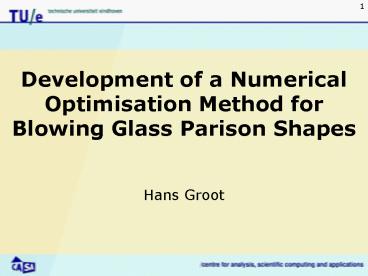Development of a Numerical Optimisation Method for Blowing Glass Parison Shapes - PowerPoint PPT Presentation
1 / 27
Title:
Development of a Numerical Optimisation Method for Blowing Glass Parison Shapes
Description:
Development of a Numerical Optimisation Method for Blowing Glass Parison Shapes. Hans Groot ... Axi-symmetric blowing of parison. 1165 oC glass. 500 oC mould ... – PowerPoint PPT presentation
Number of Views:118
Avg rating:3.0/5.0
Title: Development of a Numerical Optimisation Method for Blowing Glass Parison Shapes
1
Development of a Numerical Optimisation Method
for Blowing Glass Parison Shapes
Hans Groot
2
Overview
- Introduction
- Glass Blow Simulation Model
- Optimisation Method
- Results
- Conclusions
3
Glass Manufacturing
- Glass Melting
- Glass Conditioning
- Automatic Inspection
- Glass Forming
- Surface Treatment
4
Glass Forming
- press
- press-blow
- blow-blow
5
Blow-Blow Process
ring
preform
mould
6
Blow Model
- Flow of glass and air
- Stokes flow problem
- Viscous forces dominate
- Temperature dependent glass viscosity
- Energy exchange in glass and air
- Convection diffusion
- problem
- No viscous dissipation
- Evolution of glass-air interfaces
- Convection problem for level sets
7
Level Set Method
- motivation
- fixed finite element mesh
- topological changes are naturally dealt with
- interfaces implicitly defined
- level sets maintained as signed distances
8
Computer Simulation Model
- Finite element discretisation
- One fixed mesh for entire flow domain
- 2D axi-symmetric
- At equipment boundaries
- no-slip of glass
- air is allowed to flow out
9
Bottle Blowing Simulation
Temperature
Glass-air interfaces
10
Glass Distribution for Jar
Preform 2 breaks!
Preform 1 thickenings!
11
Inverse Problem
- Given container g find preform
- Optimisation
- Find preform that minimises difference in glass
distribution between model container and
container obtained by blow process
?
12
Least Squares Minimisation Problem
- Residual
- Minimise objective function
true interface
approximate interface
13
Optimisation Strategy
- Describe interfaces by parametric curves
- e.g. splines, Bezier curves
- Define parameters
- Compute signed distance
- Minimise
14
Modified Levenberg-Marquardt Method
- iterative method to minimise objective function
- J Jacobian matrix
- l Levenberg-Marquardt parameter
- H Hessian of penalty functions
- zi wi /ci , wi weight, ci gt0 geometric
constraint - g gradient of penalty functions
- Dp parameter increment
- r residual
15
Computation of Jacobian
- Finite difference approximation
- requires p function evaluations,
- p number of parameters
- Secant method
- updates Jacobian in incremental direction
- no function evaluations
- may fail to find descent direction
- finite difference approximation
16
Hybrid Broyden Method
Martinez, Ochi
17
Example
- Conclusions
- similar number of iterations
- similar objective function value
- Finite Differences takes approx. 3 times longer
than Hybrid Broyden
18
Preform Optimisation for Jar
Model jar
Optimal preform
Initial guess
19
Preform Optimisation for Jar
Radius 1.0
Mean distance 0.019 Max. distance 0.104
Model jar
Approximate jar
20
Conclusions
- Glass Blow Simulation Model
- finite element method
- level set techniques for interface tracking
- 2D axi-symmetric problems
- Optimisation method for preform in glass blowing
- preform described by parametric curves
- control points optimised by nonlinear least
squares - Application to blowing of jar
- mean distance lt 2 of radius jar
21
Short Term Plans
- Extend simulation model
- improve switch free-stress to no-slip boundary
conditions - one level set problem vs. two level set problems
- Well-posedness of inverse problem
- Sensitivity analysis of inverse problem
22
Thank you for your attention
23
Blowing Model 2nd blow
24
Blowing Model 1st Blow
Axi-symmetric blowing of parison
1165 oC glass 500 oC mould
25
ring
preform
mould
26
Re-initialisation by FMM Algorithm
27
Preform Optimisation for Jar
Model jar
Initial guess
Optimal preform































